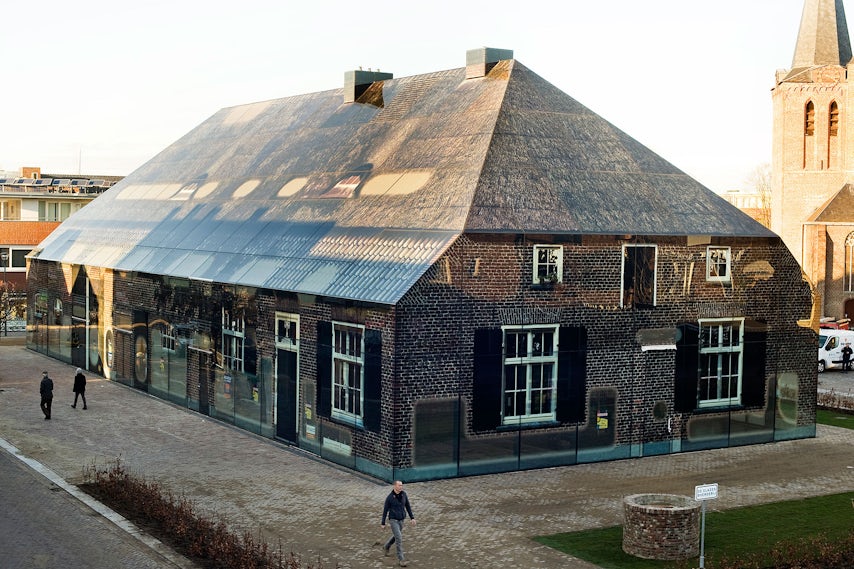Take a second look: this Dutch “farmhouse” isn’t what it seems, but a glass building that houses commercial and recreational spaces. The technology that enabled architecture firm MVRDV to conjure this illusion is actually none other than digital ceramic printing, which, by fusing ceramic inks to glass via firing or tempering, is more commonly used to produce light-diffusing, solar-control, privacy, or bird-safe glass for curtain walls, windows, and interior walls, doors, and partitions.
One of the leaders in this industry, Dip-Tech creates glass-printing machines that have enjoyed use in projects by the likes of Pritzker Architecture Prize laureate Shigeru Ban and the aforementioned cutting-edge Rotterdam firm MVRDV. Here’s a small sampling of Dip-Tech-enabled projects — from the intriguing to the practical — to inspire your own.

Printed by Metro Performance Glass; photographs courtesy Bridgit Anderson.
Cardboard Cathedral, Christchurch, New Zealand
The Shigeru Ban-designed structure was originally meant to serve as an interim church while the congregation rebuilt its earthquake-damaged church. Seating up to 700, it is constructed of coated cardboard tubes, timber, steel, polycarbonate, and concrete. But, like a traditional house of worship, it also boasts stained glass. Metro Performance Glass transformed triangular panes of clear insulated glass into tinted and translucent glass emblazoned with images pulled from photos of the original church’s rose window.

Photo courtesy Jeroen Musch, MVRDV, Persbureau van Eijndhoven.
Glass Farm, Schijndel, the Netherlands
MVRDV collaborated with artist Frank van der Salm to capture images of historical farms in the region. Approximately 19,375 square feet (or 5,000 panels) of insulated glass was digitally printed by AGC Glass Europe in full color and high resolution for the final farmhouse composition, which offers varied opacity and transparency for views, realism, and solar control.

Photo by Steve Hall / Hedrich Blessing.
O’Hare International Airport, Chicago
To enliven different sections of the airport — from a security checkpoint area to a corridor — Epstein Architects worked with graphic design firm Thirst on a range of colorful visuals that were recreated in 13-millimeter laminated glass. A total of 120 panels were processed for this project by Goldray Industries. The innovative and appealing installations resulted in a 2014 Glass Magazine Award.

Gensler’s Columbia College features a bird-friendly glazed façade by Oldcastle BuildingEnvelope®.
Columbia College, Chicago
Gensler renovated the historic 600 South Michigan Avenue but made sure to pay homage to the original building. A ghost-like image of the original façade was printed onto the exterior by Oldcastle BuildingEnvelope®, covering nearly 46 percent of the glazed area in order to reduce both solar heat gain and bird collisions. But there’s a second twist: upon close inspection of the ceramic fritting, one sees its pixels are actually small bird graphics.









